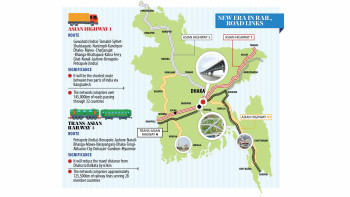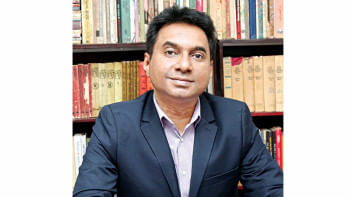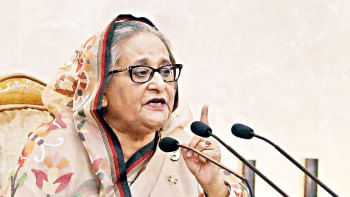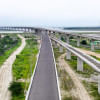The engineering and man-made challenges Padma Bridge faced

The Father of the Nation Bangabandhu Sheikh Mujibur Rahman nurtured a lifelong dream to build his "Golden Bengal" free of hunger, poverty, and discrimination. To that end, he adopted a plan to construct bridges over mighty rivers in post-independence Bangladesh.
However, Bangladesh was plunged back into a dark abyss with the assassination of Bangabandhu on August 15, 1975. His legacy was revived by his daughter after 21 long years when Sheikh Hasina led her party to victory in 1996, creating a pathway back to the development roadmap envisioned by Bangabandhu. The pre-feasibility study for Padma Bridge construction was done by the Awami League government in 1998-99, followed by a long pause during the tenure of BNP-Jamaat government, which completed the feasibility study in 2003-2005, after a great deal of dilly-dally.
Having formed the government in 2009, Prime Minister Sheikh Hasina focused on the Padma Bridge project. Its design was finalized in 2009-11, and the bridge authority of Bangladesh floated an international tender for the bridge's construction. The turbulent history surrounding the bridge in later years is known to all.
Uncertainty loomed large on the project due to local and international conspiracies. The World Bank backtracked on its decision to offer 1.2 billion dollars as credit for the bridge on grounds of a corruption allegation, later dismissed by a Canadian court. Following in the footsteps of the World Bank, ADB, JICA and IDB also pulled out of the project. The delay nearly doubled the cost.
As Bangladesh incurred a heavy blow to its dignity on the global stage, Prime Minister Sheikh Hasina made an audacious move to announce that Padma Bridge would be built with the country's own funds. Condemnations poured in from local and global conspirators, who left no stone unturned to discourage the government from taking the risk. They even continued propaganda that if the bridge was self-funded, it would create immense pressure on the country, and on top of that, no international contractor would show interest to participate in the bidding process. But, unmoved by the propaganda, Sheikh Hasina was planning to carry the project forward with support from the people of Bangladesh.

The dream project that started its journey in December, the month of victory, in 2014, is now a reality and the bridge is set to be open to the public on June 25, 2022. Every step of this journey was laced with challenges including fund allocation, river training, piling under the riverbed, and encountering rumors.
River management was one of the toughest challenges facing the project. The Padma ranks among the rivers with the strongest currents in the world. Its fierceness of current and high presence of sediment made the construction job exceedingly difficult. In 2014, just one year into the construction's beginning, a part of the construction yard including the batching plant was eaten up by the river. In 2017, a deep scour was formed in the river bed. Moreover, bank erosion was a common phenomenon at different places of Mawa and Jazira, obstructing river management. On two sides, river management was conducted across 14 kilometers (1.6 kilometers on Mawa end and 12.4 kilometers on Jazira end). The major part of river management went to Jazira part as the Padma made its way from India on the northwest side of Bangladesh. As one end of Padma Bridge is precariously close to a spot in Jazira that faces the first fierce blow of the river in the downstream region, it requires extra protection. From here the river keeps flowing in the southeast direction towards Mawa end, eroding banks on its way. The river current loses the fierceness in the meantime. The biggest challenge regarding river management was to protect the bridge by preventing river erosion.
If erosion was not prevented, that would cause the river to change its course, indicating that the bridge would stand in one place and the river would flow somewhere else. Therefore, the challenge was to keep the river's course intact, which was a multi-faceted work. At first, dredging was conducted at the riverbed (25 meters). Then giant sacks of sand (800 kg) were dropped in five phases, followed by another round of dropping sacks (125 kg) in three phases. Then concrete blocks, each weighing 165 kg, were placed at a height of one meter. After that, the river management was accomplished by putting geo bags, casting concrete blocks, and spreading CC blocks on them. Around 1,33,00,000 concrete blocks and 2,00,00,000 sand-filled geo bags were used in the process. About 212 crore cubic feet of sand had to be transferred because of river management, which was also a formidable task.
In short, the entire river management process was a challenging task that set a world record, which became possible because of the enormous experience of Chinese contractor Sinohydro Corporation and the vision and effective decisions of the panel of experts.
The biggest challenge, however, was encountered in piling, which compelled the concerned to change the design several times, culminating in the longer duration of the project completion. An awe-inspiring 122 meters of piling were conducted at the riverbed, making a global record. The world-famous German hammer was employed, which had also been made in a customized way for this bridge. At the Mawa point of the Padma river, 1,40,000 cubic feet of water flow every second, ranking only after the river Amazon. During the piling design, it was also taken into account how the riverbed would change in 100 years. A study showed that the riverbed soil might shift up to 65 meters in a century. Following a rigorous calculation, the piling depth was set at 122 meters, each pile having a radius of 3 meters and being made of 70 mm thick steel. Even if it undergoes rusting under water in a 100 years, a significant amount of steel used for piling will still survive.
The piling became extra difficult because the bridge is curved. A remarkable difficulty was faced with 14 pillars over a year due to the different composition of the soil in the riverbed of Padma. The construction process was delayed several times as the design of these 14 pillars had to be changed over and over again. The number of piles used for each pillar had to be increased from six to eight. It was also taken into account during the design of the pile if a pillar would be able to withstand a collision with a ship at the time of a disaster. Screen grouting (a fine layer of cement) was done on top of the piling to increase the capacity of piles to carry loads.
Astounding as it may sound, apart from technical challenges, there was another regarding rumors spread by a quarter who could not tolerate the success story of Bangladesh. They circulated the false story that the construction of Padma Bridge would require severed human heads. The rumor became so widespread that parents suffered from paranoia regarding their children being kidnapped. It broke hearts when a woman inquiring about her child's admission to a school in Dhaka was mistaken for a child abductor and lynched on the spot only to be discovered later that she was innocent. Prime Minister Sheikh Hasina made a strict order that any such rumor would be dealt with an iron hand.
After braving a sea of man-made difficulties and engineering challenges, Padma Bridge is finally standing as a miracle above the mighty river Padma, connecting districts and promising a solid economic growth for the coming 100 years. The dream journey is open to the public tomorrow, a day to be marked with golden letters in history.
The writer is a professor at the Civil Engineering department of BUET and also worked as a consultant in the Padma Bridge project.

 For all latest news, follow The Daily Star's Google News channel.
For all latest news, follow The Daily Star's Google News channel. 











Comments